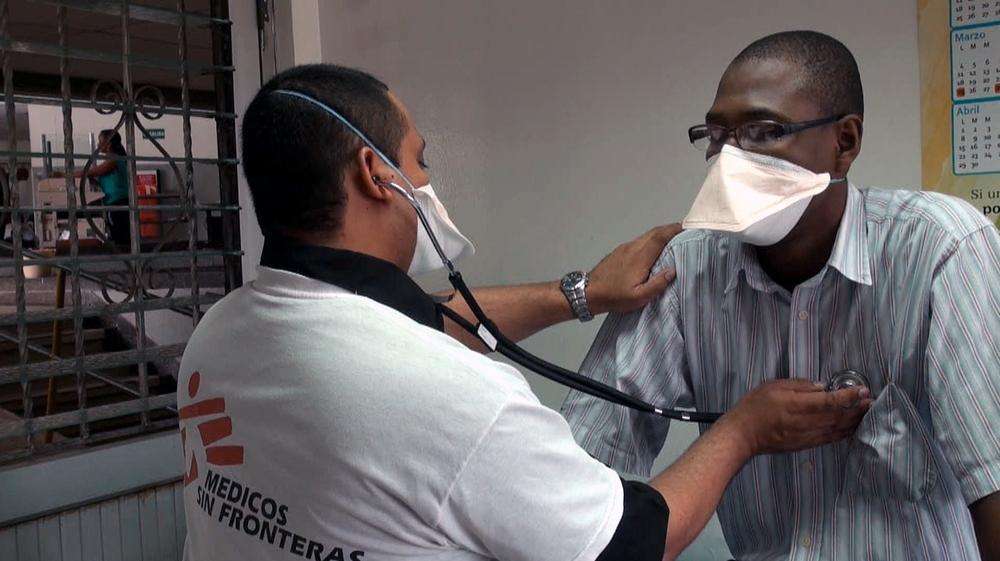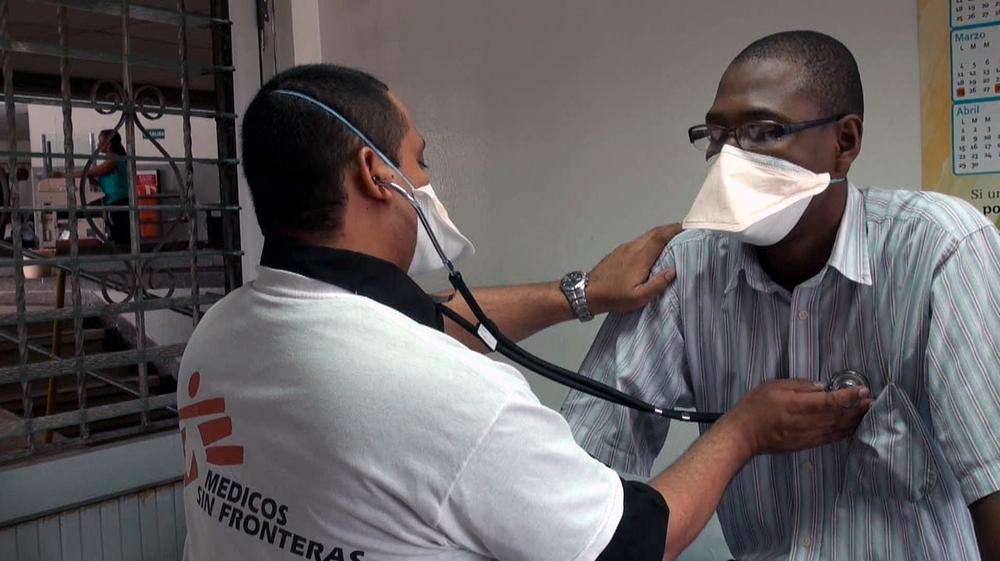In Buenaventura, a port city on Colombia's Pacific coast, there are three times more cases of tuberculosis than in the rest of the country. The failures of the city's health system impede access to appropriate care, and, once care is obtained, the painful side effects and lengthy treatment pose further obstacles to recovery. Doctors Without Borders/Médecins Sans Frontières (MSF) has supported the Colombian National Program against Tuberculosis since 2010, working to improve the diagnosis and treatment of the disease in Buenaventura.
The crisp air of the Andean peaks warms gradually as you travel along the road leading into Buenaventura, giving way to the moist Pacific climate. Barrios extend along both sides of Simón Bolívar Avenue, the main artery that divides the city and leads to Colombia's largest port. Here, the goods circulating and the general bustle hide a high unemployment rate and precarious living conditions. Buenaventura has another important characteristic: a high prevalence of tuberculosis, fostered by poverty. “The incidence of tuberculosis in Buenaventura is three times higher than that in the rest of the country,” explains Luis Fernando Jiménez Abelló, MSF TB manager in Buenaventura. “[But what’s] most striking is the percentage of people who develop a resistant form of the disease in the primary infection phase.”
The System’s Problems and Weaknesses
In Colombia, “tuberculosis is seen as a political issue, rather than being managed as a public health problem,” says Jiménez Abelló. “The authorities lack the will to improve treatment because they have other interests.” The city’s development follows two separate tracks. The port authority, which operates under the town’s auspices, just purchased five cranes at $25 million each. However, investment in public health is at a virtual standstill.
Here in the lobby of Buenaventura’s luxurious Hotel Torre Mar, the city’s busy health director, Dr. David Caicedo, leaves the workshop he is attending to answer questions. “The national authorities are not aware of the extent of the tuberculosis problem in Buenaventura,” he says. “There are major weaknesses in the Colombian health system and in TB treatment—specifically a lack of trained workers—but I’m still confident.” His rhetoric is encouraging, but, sadly, it does not reflect reality. Few initiatives are actually underway.
The plethora of actors involved in diagnosis and treatment delivery in Buenaventura feeds confusion and creates inefficiencies in the health care system, which has already been weakened by the cost of treatment and a lack of certain drugs at the national level.
“Between May and July of this year, we ran out of the main drug used in the intensive phase (the first two months) of treating regular TB,” Jiménez Abelló says. “Given that we know that stock-outs promote the development of drug resistance, we can call this a health emergency.”
Treatment and Side Effects
Several patients wait their turn at the entry to the Independencia health center, which specializes in tuberculosis. Everyone here is required to wear a mask. Further along the hallway, the door to a room on the right is half-open. This is where patients with a form of drug-resistant tuberculosis come every day for treatment. Some forty containers are stacked in the cupboard on the left side of the room. Each is labeled with a first name: Maria José, Carlos, Jaime, and many more. “Each container corresponds to a patient’s treatment,” Jiménez Abelló explains. This treatment is known as directly observed therapy, or DOTS. Patients must take their medicine every day as a health care worker watches. A young girl is taking her drugs. Using her finger, she points out the order in which she wants to take each medication. As she works her way through them, the time between swallowing each pill lengthens. She takes an ever-larger gulp of water and the grimace on her face becomes more pronounced. “I take 20 pills every day—each one is a different size, color, and texture,” she says. She suffers from an extensively drug-resistant form of tuberculosis.
The treatment is complicated, particularly because it produces many side effects. Maria Victoria completed her treatment five months ago. “I had a lot of headaches and stomach aches,” she recalls. “I lost my appetite and I felt very weak. Sometimes I couldn’t even keep down a glass of water.”
Tuberculosis is a contagious infectious disease. There is no vaccine and the clinical signs of the illness vary. It is caused by a mycobacterium tuberculosis complex composed of many bacteria, primarily the Mycobacterium tuberculosis (Koch’s bacillus). Drug-sensitive TB can be treated in a few months, but treating a drug-resistant form can take more than two years.
Stigmatization and Isolation
TB patients in Buenaventura are still stigmatized. “I think people here are more afraid of tuberculosis than of HIV/AIDS,” says one patient. “I don't understand why.” Many patients confide that they suffer from the community’s attitude and experience rejection and isolation. “I didn’t leave my house,” Maria Victoria says. “I only went from the house to the health center. When I was in the street, I didn’t look at anyone. Very few people dared to touch me.” This 45-year-old patient completed her treatment just five months ago and becomes emotional when she remembers these painful moments.
“This [stigmatization] may be due to the method of transmission or the fact that a person with TB is readily identifiable because of the mask,” says Juan Carlos Arteaga España, MSF project psychologist. “But most importantly, I think there is a lack of information and education about this disease.”
A Multidisciplinary Approach
The length of treatment, the daily regimen of pills, alcohol and drug dependency, and stigmatization lead many patients to abandon treatment. The severe side effects are also discouraging. Maria de los Angeles is an example. She was one of the patients whose TB treatment MSF monitored—before she abandoned treatment. “The side effects were unbearable,” she says. “I hurt everywhere. I couldn’t go on like that.”
To encourage drug-resistant patients to comply with their treatment, MSF offers a comprehensive, multi-disciplinary treatment approach that combines medical, psychological, and social support. “Patient support plays an important role in minimizing treatment abandonment,” Jiménez Abelló explains. “Organization also plays an important role in early detection and diagnosis of TB cases.” The team simultaneously monitors 15 public and private health care facilities that treat drug-sensitive TB patients.
MSF launched its TB treatment program in Buenaventura nearly three years ago. This year, the first patients with drug-resistant TB completed their treatment. “When they told me that the treatment was over and that I was well, I turned everything upside down at the health center,” remembers Maria Victoria, who completed her treatment five months ago. “I screamed, I cried, I hugged and thanked all the medical staff. I went down on my knees. It was like I had returned to life.”
“I didn’t leave my house... I only went from the house to the health center. When I was in the street, I didn’t look at anyone. Very few people dared to touch me.”
Maria Victoria





